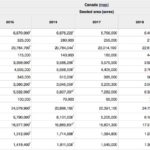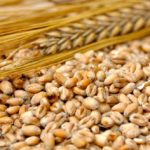MarketsFarm — Canadian farmers intend to seed more spring wheat and less canola in 2019, according to Statistics Canada survey results released Wednesday. Additional shifts are also likely in subsequent reports, as dry conditions in southern Alberta and Saskatchewan may alter some intentions. Statistics Canada forecast canola area for 2019 at 21.3 million acres, which […] Read more

StatsCan confirms smaller canola acres, more wheat

Canadian farmers to reduce canola plantings by seven per cent
Winnipeg | Reuters — Canadian farmers intend to plant seven per cent fewer acres of canola this spring compared with a year earlier, even less than expected by analysts and traders, as a dispute with China hampers demand, a government report showed on Wednesday. China and Canada are locked in a diplomatic and trade dispute […] Read more

Feed weekly outlook: Barley acreage buoyed despite current prices
MarketsFarm — International demand for Canadian feed barley has been strong thanks to a 2018 growing season drought in Australia that limited exportable supplies. China purchased nearly 950,000 tonnes of Canadian barley in the first seven months of the 2018-19 year, significantly above the five-year average. However, feed markets in general are quite sluggish ahead […] Read more

Views differ on crop exports to China other than canola
MarketsFarm — Depending on whom one has spoken with, there are differing views as to grain exports to China other than canola. The federal government has stated there have been no export issues outside of canola. “The current actions taken by China are limited to canola seed, and we have not received any indication of […] Read more

It’s not glamorous, but feed barley is a bright spot
Demand has shot up over the past year but there’s a caveat — China has been the big buyer
Reading Time: 4 minutes Barley growers will have a tough choice this spring: Target an oversaturated malt market or go for the red-hot one — feed barley. “It’s got to be a question a lot of farmers are asking themselves, especially if you’re in a region where feed and malt prices have been about the same,” said Geoff Backman, […] Read more

Four tips for better barley production
Four tips to better barley production Whether or not you’re using variable rate technology in your malting barley crop, it is important to use due care and attention when establishing the cereal crop, say two long-time Agriculture and Agri-Food Canada researchers. John O’Donovan, now retired malting barley agronomist ,and Kelly Turkington, a plant pathologist with[...]
Read more
Read more

Feed weekly outlook: Barley prices correct off recent highs
MarketsFarm — Feed markets in Western Canada have softened slightly following a jump in prices earlier this month. Nelson Neumann, a grain trader for Agfinity, said barley supply was tight earlier in the month as buyers rushed to secure their feed before spring road bans, seeding season and poor weather conditions hampered deliveries. “We saw[...]
Read more
Read more

Klassen: Feeder market holds value
Western Canadian feeder cattle prices were relatively unchanged compared to seven days earlier. Buying interest for yearlings was somewhat stronger while calves in the eastern Prairie regions were softer. Moderate temperatures are in the seven-day forecast for most of Western Canada, so the risk discount due to adverse weather has evaporated. Barley jumped an additional[...]
Read more
Read more

Klassen: Feeder market sends mixed signals
Compared to last week, western Canadian yearling markets were steady to $4 lower while calves were steady to $2 higher. Barley prices have jumped $3-$6 per tonne over the past week, with winter conditions hindering off-farm logistics. Alberta packers were buying fed cattle in the range of $149-$150 last week; however, in Nebraska, fed cattle[...]
Read more
Read more

Canola exports still sluggish, but grains solid
Canadian canola exports continue to lag behind the year-ago pace, with large supplies in the commercial pipeline, according to the latest weekly data from the Canadian Grain Commission. Canada only exported 69,900 tonnes of canola during the week ended Sunday, well below the 205,500 tonnes that moved the previous week. Total canola exports during the[...]
Read more
Read more

